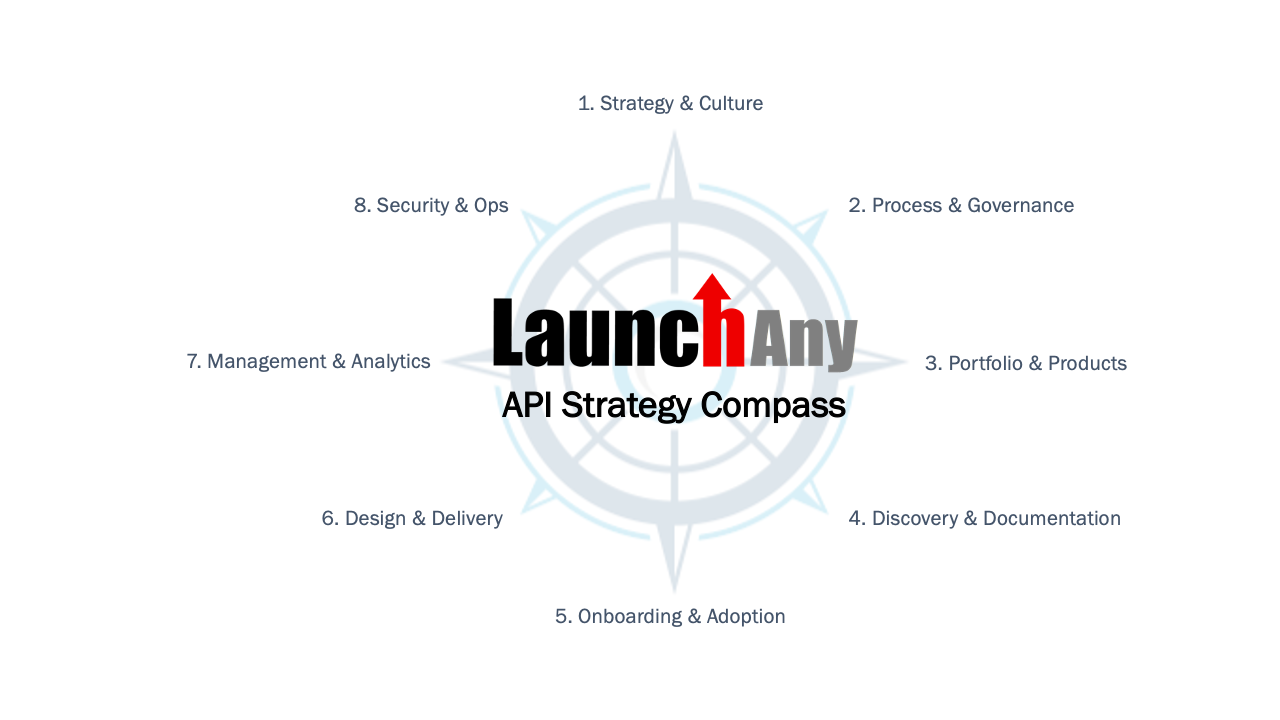“Where you are headed is more important than how fast you’re going, yet people are consumed with speed rather than direction.” – Stephen Covey
Organizations may encounter difficulties in the early days of their API program. This is often the result of seeing an API program simply from the technology perspective, such as API design, rather than from a holistic view.
LaunchAny has identified 8 disciplines that are critical to delivering an effective API program. These disciplines are summarized below:
1. Strategy & Culture
Summary: Is the API strategy clear, articulated, and driving growth?
For an API program to be effective, a clear strategy is required. This should include a clearly articulated set of objectives and target state for the API program. It also requires support from executive leadership. With these items in place, effective change management is required to bring the entire organization into an API-first culture. This doesn’t happen immediately but requires thoughtful and consistent execution. Without these elements, the API program will be under supported, under funded, and de-prioritized when challenges arise.
2. Process & Governance
Summary: Are decisions related to the API program executed consistently across the organization?
If teams are left on their own, APIs will be designed and delivered inconsistently. Lightweight API governance models must be established via a Center for Enablement (C4E), Center of Excellence, or API Guild. The process should be clear, support existing delivery processes, and be understood clearly. Over time, these processes may be scaled to support a federated model for larger organizations.
3. Portfolio & Products
Summary: Are all digital assets organized into a digital portfolio and aligned with business needs?
Managing digital assets as a portfolio is essential for organizations managing APIs across business units or lines of business. Digital portfolios may span internal, partner, and external APIs and are typically grouped into capability domain areas. One or more product managers are responsible for stewarding the capability domains to align with business capabilities and organization-wide initiatives.
4. Discovery & Documentation
Summary: Are the APIs discoverable and well-documented?
An effective API program requires easy discovery of available APIs. A developer portal is offered for browsing and searching for existing APIs, encouraging reuse. Reference documentation is considered minimal documentation with supplemental step-by-step guides for common scenarios to help developers get started quickly. Documentation should also target non-developers to help them better understand the digital capabilities available.
5. Onboarding & Adoption
Summary: Do APIs enable low-friction onboarding and integration support?
Developers must be able to onboard quickly and easily with the organization’s API program. This includes self-service generation of API tokens for authorization. A getting started guide should be offered to help the developer become familiar with the API. A FAQ page helps to address common questions developers may encounter when first starting to use the API. A good support program helps to address questions not answered in the documentation or to troubleshoot a problem.
6. Design & Delivery
Summary: Are APIs consistently designed and delivered?
APIs are forever. Once the design is frozen, it may be improved but existing operations cannot be altered. Therefore, a repeated API design process is important for surfacing issues early, before delivery. Once designed, an API design should be reviewed by a governing group and/or peers. Delivery should include proper API testing procedures to ensure the implementation meets the intent of the design. Finally, completing documentation is part of the delivery process and are not meant to be a last-minute task.
7. Management & Analytics
Summary: Are APIs owned, managed, and continually improved?
APIs must evolve over time to meet the continually changing needs of the workforce, partners, and the marketplace. They must be treated as products that continually evolve rather than projects that are completed and enter maintenance mode. Establishing proper API management techniques, including the use of analytics to monitor API usage, is important to improve APIs. Establishing a marketing strategy for internal and external APIs helps to build awareness and increase reuse metrics. For API products, marketing may also include promotions targeting developer communities and influencers.
8. Security & Ops
Summary: Do all APIs incorporate security by default and proper operational concerns?
A great API design with poor operational procedures and security can result in unnecessary outages, malicious activity, and data leaks. Establishing proper delivery and operational procedures ensures APIs are available and meet established SLAs. Organizations must review their APIs for security concerns both at design-time and run-time. All of these activities should center on a proper API management layer that enforces proper authorization and alerts operations teams when issues surface.
Putting It All Together
The API Compass framework provides a concise, visual representation of your API program and strategy across these 8 disciplines. We help you perform an assessment of your API program, identify areas for improvement, and create a prioritized roadmap to help get you there.

With a clear understanding of where you are and where your API strategy is heading, you can focus your execution strategy in the appropriate areas.